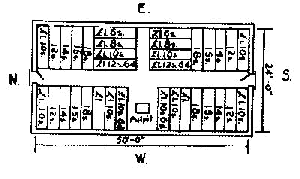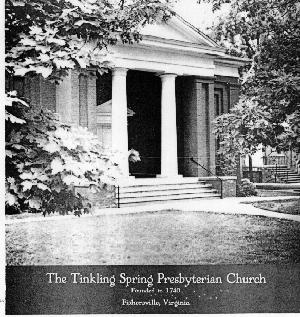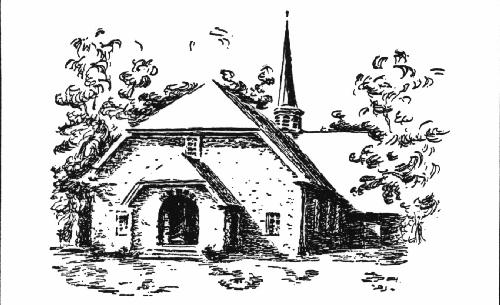Tinkling Spring Photo Album
Deeply imbedded in the history of the settlement of Augusta County is Tinkling Spring Church. The first settlers from the north were John Lewis who arrive in 1732 and William Beverley who was given a large land grant in 1736. The Scotch-Irish Presbyterians who followed lost no time in forming the Triple Forks of the Shenandoah Congregation and in petitioning the Donegal Presbytery for the services of a minister. Two centers of worship developed--Tinkling Spring and the Augusta Stone Meeting Houses. These pictures are from Howard McKnight Wilson's The Tinkling Spring: Headwater of Freedom, A study of the Church and Her People, 1732-1952, permission granted by Tinkling Spring Church.

Tinkling Spring Church was officially founded in 1740. The first meeting house was a log cabin measuring twenty-four by fifty feet.

The floor plan shows seating arrangement and pew rent. The small pulpit was located along the west wall. The interior was severely simple and the floor was the ground over which the the sanctuary was constructed. The pews were simple benches without backs, probably made of split logs.

This monument, which stands outside the Fellowship Hall, reads, "Sacred to the Memory of the Immigrants to this valley who turned the wilderness into habitations." It lists the names of the original members who were assessed twelve shillings each to build the first meeting house. Administratively, the membership was divided into three Quarters headed by John Christian, William Wright, and John Finley. Christian's quarter included families named Black, Cowin, Wilson, Long, Bell, Alexander, Stewart, Patton, Hall, Robison, Cristian, Davison, McCollock, Caldwell, Armstrong, Rutledge, Henderson, Conegham, Thomson, Scott, Gamel, Ramsey, Preston, Maxwell, McDonal, Russell, Lewis, Hutchison, McClanahan, Brackenridge, and McCollock. Wright's quarter included families named Smith Hutchison, Palmer, Thomson, Moday, Frazer, Johnston, Logan, Henderson, Scileran, Black, Cear, McCune, Fergeson, and Wright. Finley's quarter included families named McClure, Turk, Gay, Finley, McCollock, Gelaspey, Edmiston, Campbell, Stewart, Peterson, Cear, Tays, Steel, and White. (Photo courtesy of Ellen L. Moffett)

Interest in building a new meeting house began in 1777 when the subscribers agreed to pay the costs. However, completion of the building was delayed by the war and it wasn't until about 1792 that the Stone Sanctuary shown here was completed.
 The present church building was erected in 1849 and remodeled in 1916. |
 The statue of Pioneer Woman was chosen by Howard McKnight Wilson as the Frontispiece in his The Tinkling Spring: Headwater of Freedom, A study of the Church and Her People, 1732-1952. |

Augusta Stone Meeting House, Ft. Defiance, Virginia, 1740
[The map of Beverley Manor and Bordon Grants shows its location just outside the Manor line.]
The Congregation of the Triple Forks of the Shenandoah, established two meeting houses in 1740--Tinkling Spring and the Augusta Stone, both served by Rev. John Craig. The original Augusta Stone building was a log cabin similar to that at Tinkling Spring. The stone building seen here was built 1747-1749 and was to serve both as a meeting house and a fort. Still serving its people today, it has the distinction of being the oldest Presbyterian Church in continuous use in Virginia.

Last Updated: August 2020